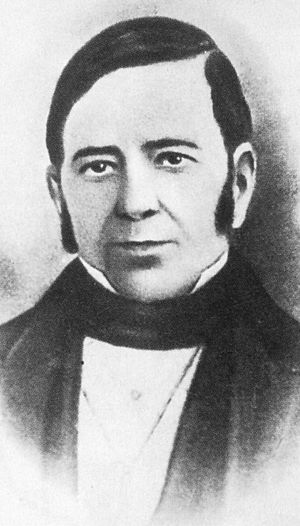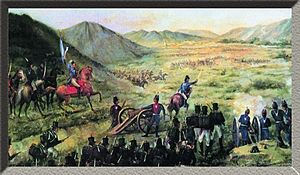Pío de Tristán facts for kids
Quick facts for kids
Pío de Tristán
|
|
|---|---|

Pío de Tristán, the last Viceroy of Peru
|
|
| Interim Viceroy of Peru | |
| In office December 9, 1824 – December 30, 1824 |
|
| Monarch | Ferdinand VII |
| Preceded by | José de la Serna |
| Succeeded by | Position abolished |
| 2nd President of South Peru | |
| In office October 12, 1838 – February 23, 1839 |
|
| Preceded by | Ramón Herrera y Rodado |
| Succeeded by | Position abolished |
| Personal details | |
| Born | July 11, 1773 Arequipa, Peru |
| Died | August 24, 1860 (aged 87) Lima, Peru |
| Relatives | Flora Tristan, niece |
| Occupation | Politician, general |
| Known for | Last Spanish viceroy of Peru, last president of South Peru |
| Military service | |
| Allegiance | |
| Years of service | c. 1780–1824 |
| Rank | Field marshal |
| Battles/wars | Rebellion of Túpac Amaru II War of the Pyrenees Cuzco Rebellion of 1814
|
Juan Pío Camilo de Tristán y Moscoso (born July 11, 1773, in Arequipa, Peru – died August 24, 1860, in Lima, Peru) was an important Peruvian general and politician. He served as the second President of South Peru for a short time. He was also the last person to be called the viceroy of Peru, though he didn't actually hold power in that role.
Contents
Life Story of Pío de Tristán
Early Years and Military Career
Pío de Tristán was born into a rich family in Arequipa. His family was proud to be connected to the famous House of Borgia. When he was older, Tristán went to Spain. There, he fought against the French in the War of the Pyrenees from 1793 to 1795.
After returning to Peru, he became the alcalde (mayor) of Arequipa in 1808. He was a general in the Royalist army, which supported the Spanish king during the wars for independence. In June 1811, he fought in the Battle of Guaqui, where the Royalist forces won.
The Battle of Salta
After the Battle of Guaqui, Tristán led his Royalist army into what is now Argentina. However, he was defeated twice by General Manuel Belgrano, who was a rebel leader and a former classmate of Tristán's from Salamanca.
The Battle of Salta happened on February 20, 1813. Belgrano's forces completely defeated Tristán's troops. This was a very important victory because it was the first time the flag of Argentina was used in a military win.
After his defeat, Tristán signed a peace agreement that lasted 40 days and then went back to Peru. This loss for the Royalists helped the rebels take control of the northern part of the old Viceroyalty of Rio de la Plata. It also led to revolts against the Spanish in other areas like Charcas, Potosí, and Cochabamba (which are now in Bolivia).
Later Political Life
In December 1824, the Spanish Viceroy José de la Serna was defeated at the Battle of Ayacucho. This battle effectively ended Spain's control over Peru. Since Tristán was the highest-ranking Spanish military officer left, he became the temporary viceroy. His main job was to hand over power to the new independent Peruvian government.
After this, Pío de Tristán decided to stay in Peru. He became very active in Peruvian politics. He worked as a prefect and military commander in Arequipa. He also served as Peru's minister of war and marine, and later as the Minister of Finance of Peru in 1836.
He played a part in creating the Peru-Bolivian Confederation, a union between Peru and Bolivia, and was its foreign minister. From October 12, 1838, to February 23, 1839, he was the president of the state of South Peru within this Confederation. He passed away in Lima in 1860.
He lived in the Tristán del Pozo House, which belonged to some of his relatives. His niece, Flora Tristan, who was a famous feminist and socialist writer, wrote about him and the house in her travel book Pérégrinations d'une paria (Peregrinations of a Pariah, 1838). Flora Tristan was also the grandmother of the famous French painter Paul Gauguin.
See also
 In Spanish: Pío Tristán para niños
In Spanish: Pío Tristán para niños
- Tristán family:
- Domingo Tristán
- Flora Tristán
- Victoria Tristán, wife of President of Peru José Rufino Echenique


